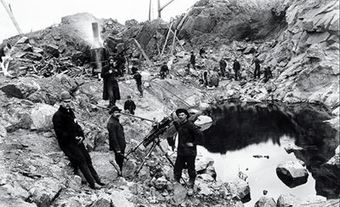Radium
Radium (Ra) is a rare radioactive metal found with naturally occurring URANIUM (about 1 part radium to 3 million parts uranium). It was discovered in 1898 by Pierre and Marie Curie and G. Bémont, who chemically treated pitchblende, a uranium ore obtained as a byproduct from the Joachimsthal silver mine in Bohemia. In 1902, Marie Currie isolated the first pure salt of radium (radium chloride) and in 1910, she and A. Debierne prepared radium metal. The usefulness of radium as a treatment for certain malignancies was soon recognized.
In the early part of the 20th century, radium was recovered from mines in Bohemia and for other mineralized deposits in Australia, England, the Malagasy Republic, Portugal, the USSR and the Republic of South Africa. Most of the world's radium has come from the Shinkolobwe mine, in what is now Zaire (beginning in 1921), and the Port Radium mine near Great Bear Lake in the NWT (beginning in 1933). The high-grade pitchblende concentrates were treated at radium refineries at Oolen, Belgium, and PORT HOPE, Ont, respectively. Both mines closed in the late 1930s but were reopened in the early 1940s as sources of uranium. Radium was recovered as a byproduct of uranium at the Port Hope refinery until 1953.
The most important use for radium has been to destroy cancer cells. Radium compounds sealed in tubes or needles were implanted in patients at cancer sites. Radium has also been employed industrially, eg, in luminous paint used on the dials of watches and instruments. However, there is now little demand for radium, since radioisotopes such as COBALT -60 can be processed more cheaply and are more effective in most applications.

 Share on Facebook
Share on Facebook Share on X
Share on X Share by Email
Share by Email Share on Google Classroom
Share on Google Classroom

